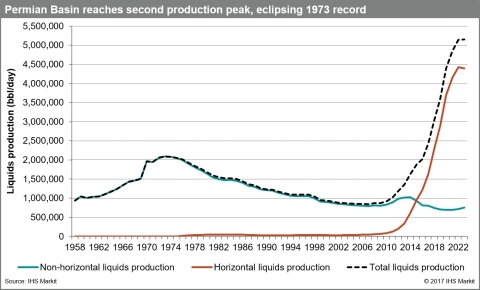HOUSTON--(BUSINESS WIRE)--The prolific Permian Basin, a mature hydrocarbon ‘super basin’ located in west Texas and southeastern New Mexico, reached a new oil-production record of 815 million barrels or more* in 2017—far exceeding its previous peak of 790 million barrels set in 1973, according to new analysis from IHS Markit (Nasdaq: INFO), a world leader in critical information.
(*IHS Markit will revise final production figures after operators report 2017 year-end production).
The 2017 production milestone does not just crawl past the previous 1973 peak, but eclipses the 44-year-old previous production record by more than 25 million barrels, IHS Markit said.
“The magnitude of the rebound in Permian Basin liquids production is unprecedented,” said Reed Olmstead, director, energy research and analysis, IHS Markit. “Not so long ago, many in the industry were saying the Permian was dead, but the Phoenix has again risen from the ashes and is soaring to new heights. The Permian Basin is on track to add more than two million barrels per day in new production since 2007, and after the final-year production count is in for 2017, we will see the previous all-time liquids-production peak of 2.16 million barrels per day during 1973 surpassed by a significant margin, with total Permian volumes at roughly 2.75 million barrels per day. In turn, this surge in Permian production is projected to push total U.S. liquids production to a new all-time high by the end of 2018. We see U.S. production exceeding 10.5 million barrels per day by the end of 2018.”
According to the IHS Markit U.S. Energy Well and Production database, peak annual liquids production for the Permian Basin during 1973 was nearly 790 million, an average of nearly 66 million barrels of oil per month. Peak-month liquids production in the Permian during 1973 occurred in September, with slightly more than 68 million barrels produced.
By mid-year 2017, average monthly production already exceeded the best month of Permian production during the former peak year of 1973. For 2017 year-to-date through July, Permian liquids production exceeded 484 million barrels, or an average of slightly more than 69 million barrels per month.
Aside from the overall E&P activity and related investment that is significant to the region, the state, and operators in the basin, “the implications for U.S. energy security are significant—since we have become, in a relatively short period of time, more self-sufficient in terms of energy supply and are less reliant on imports,” Olmstead said.
Longer-term implications for Permian Basin oil supplies are evolving, and the future looks promising, according to IHS Markit energy researchers, who have completed the first, three-year phase of a massive Permian Basin research project entitled: The Permian Basin Interpreted in 3D: The IHS Markit Permian Basin Unconventionals Kingdom Geology Project. It models and interprets the giant basin’s key geologic characteristics to better estimate its remaining hydrocarbon potential, and initial results indicate the giant basin still holds an estimated 60 billion to 70 billion barrels of technically recoverable resources – about twice as much as the cumulative oil production to date. The initial research from the analysis was reported Sept. 25, 2017: https://t.co/Xk2nY92lj1
Since it first began producing in the 1920s from the famed Santa Rita #1 well, the legendary Permian Basin has produced more than 39 billion barrels (cumulative) of oil reaching peak volumes in 1973. As conventional oil production in the play declined steadily during the following three decades, many in the industry thought the Permian’s best days were behind it, but unconventional drilling and completion technology changed the game in the 2000s. This advance made possible the extraction of unconventional shale resources that were previously uneconomic to produce, and changed the view of geologists, who, for decades, had bypassed these less desirable targets in favor of conventional reservoirs.
“The Permian is one of the most prolific basins in the history of oil production, with the onset of horizontal drilling and new completion technology during the past decade, the production decline in the Permian has been reversed and the basin has eclipsed its previous peak,” said Pete Stark, Ph.D., executive director, upstream research at IHS Markit. “The significance of this second production peak cannot be overstated, since it truly revived a basin, and in many ways, the U.S. E&P industry. When we consider the impact on the world’s crude markets, the Permian has to be considered a global disrupter.”
IHS Markit says the Permian Basin is of such significance to the global oil and gas industry that the basin is the model IHS Markit uses as the benchmark for its ongoing research study on super basins, entitled Super Basins: The Basins that Keep on Giving Analysis. The IHS Markit researchers identified more than onshore 25 ‘super basins’ that have multiple reservoirs and source rocks, diverse play types across numerous geologic horizons, infrastructure with access to markets, and established service sector and supply chains.
To earn ‘super-basin’ status, the IHS Markit analysis said, basins must have achieved greater than 5 billion barrels of cumulative production and have an estimated remaining production potential that is greater than 5 billion barrels. (The initial results, the IHS Markit Super Basins: The Basins that Keep on Giving Analysis, were reported March 3, 2017: https://t.co/MlOAzJv0tN
IHS Markit estimates the potential upside recoverable oil from 25 global super basins to be approximately 840 billion barrels. This is far larger than the resources required to generate the 40 million barrels per day of new oil supplies that may be required to meet estimated 2040 global oil demand, IHS Markit said.
“The key question for truly optimizing the potential of these super basins is whether the global petroleum industry has the wherewithal to successfully implement the Permian Basin model in mostly onshore, international super basins,” said Jerry Kepes, executive director, plays and basins at IHS Markit. “Established, mature super basins offer many potential advantages including lower subsurface risks, established infrastructure, existing supply chains and service sectors, as well as access to markets, but above-ground challenges pose substantial hurdles.”
To better explore this potential, IHS Markit and the AAPG (American Association of Petroleum Geologists) are co-sponsoring a special Super Basins Executive Conference, March 27-29, 2018, in Houston to discuss and consider the future role of super basins in meeting tomorrow’s oil and gas supplies. An agenda and registration information for the conference is available at http://superbasins.aapg.org/2018/
To speak with Reed Olmstead, Pete Stark or Jerry Kepes, please contact Melissa Manning at melissa.manning@ihsmarkit.com. For more information on The Permian Basin Interpreted in 3D: The IHS Markit Permian Basin Unconventionals Kingdom Geology Project or the IHS Markit Super Basins: The Basins that Keep on Giving analysis, please contact sheana.hamill@ihsmarkit.com.
About IHS Markit (www.ihsmarkit.com)
IHS Markit (Nasdaq: INFO) is a world leader in critical information, analytics and solutions for the major industries and markets that drive economies worldwide. The company delivers next-generation information, analytics and solutions to customers in business, finance and government, improving their operational efficiency and providing deep insights that lead to well-informed, confident decisions. IHS Markit has more than 50,000 key business and government customers, including 85 percent of the Fortune Global 500 and the world’s leading financial institutions. Headquartered in London, IHS Markit is committed to sustainable, profitable growth.
IHS Markit is a registered trademark of IHS Markit Ltd and/or its affiliates. All other company and product names may be trademarks of their respective owners © 2017 IHS Markit Ltd. All rights reserved.




